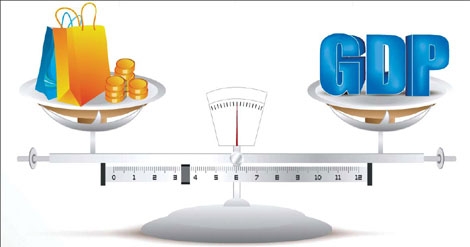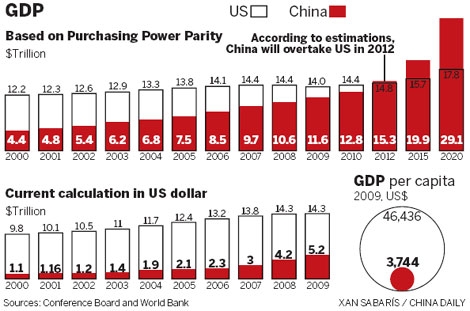Economy
Getting what you pay for
Updated: 2010-12-10 11:06
By Zhang Ran (China Daily European Weekly)

Purchasing power set to present another side of China's economic situation
Here are some reasons why it can be comfortable living in a modern Chinese city:
You pay only 5 yuan ($0.75) to have your pants altered. In Sydney, that can cost 60 yuan ($9).
Even with the rising cost of cotton on the Chinese mainland, you can still buy a high quality shirt for 40 yuan ($6) at the Xiushui Street shopping area in downtown Beijing.
You can also enjoy a fancy candle-lit dinner for 200 yuan ($30) in Shanghai. In Paris, that can set you back triple that amount.
Also, while McDonald's has raised its menu prices in China by up to 1 yuan per item due to the cost of ingredients, you can still get a Big Mac for 14 yuan ($2.1). The same item costs $3.71 in the United States.
By taking into account the prices of the same goods in different countries, US-based research group Conference Board released a report last month that forecast China's GDP surpassing that of the US by 2012.
"In just two years, the Asian country could even overtake the US as the world's largest economy - at least by one economic measure," the research group reports in its annual global outlook.
The measure, purchasing power parity (PPP), can also be understand easily through a well-known theory, the so-called "Big Mac Index". The term first appeared in The Economist magazine 25 years ago. For every year since, the magazine discloses the result of the index by comparing different prices of a McDonald's Big Mac in different countries. The index is widely viewed as a barometer for the applicability of one country's exchange rate. It can also suggest how some developing countries, including China, may have "undervalued" currencies.
Applying the PPP
Yet, most Chinese had not heard of the theory until recently, when China's National Bureau of Statistics (NBS) announced that the nation would participate in the World Bank's International Comparison Program (ICP) and apply the PPP to calculate its GDP in 2011.
To that effect, an ICP inter-ministerial coordination group has been established, involving 10 departments, including the NBS, the Ministry of Finance and the National Development and Reform Commission.
The ICP is a global statistical cooperative project whose main purpose is to measure the PPP of currencies. It uses the PPP as the conversion factor and represents GDP with a unified currency unit, thereby providing an actual comparison and evaluation of the national economic scale and structure of different countries.
Economists have pointed out that China's economic situation has received much international attention because the country is a major stakeholder of the World Bank and International Monetary Fund (IMF). Currency exchange rates have been fluctuating frequently in recent years, resulting in more problems with using them to calculate GDP. Another measure is needed to obtain "more reasonable" GDP figures, analysts say.
"In theory, the PPP can more objectively reflect the difference in economic scale between different countries," says Qiu Jun, chief statistics officer with the NBS' Guangdong bureau.
But economists point out that with this measure, the purchasing power of some emerging and developing countries will also be exaggerated at certain levels.
"It is necessary to note that there is an obvious deviation in using the PPP measure," says Zhang Biqiong, professor at the Beijing-based Central University of Finance and Economics.
Zhang says that the measurement only compares internationally tradable items such as clothes or food, while non-tradable items such as services, property, medical care or education are not included.
Also, while the price of a Big Mac is cheaper in China, only a small proportion of Chinese can afford it and most of these people live in big cities. Contrary to what Americans or Europeans purchase, rural Chinese families never get a chance to see a Big Mac, far less consider it as a "low-end fast food".
China also lags far behind the US in another measure of economic well-being - output per person. In 2009, US GDP per capita stood at about $46,000, according to the IMF.
By comparison, China's GDP per capita was less than $4,000.
"Viewed in this perspective, the PPP measure is more suitable for comparing the overall national economic scale rather than the quality of an individual's life," says Sun Lijian, professor at Fudan University.
Earlier in 2005, China had already sent sample prices selected from 11 cities to participate in the ICP project.
"The sample is too limited to represent the whole situation of China," says Qiu from the NBS' Guangdong bureau.
The new round of ICP surveys, which includes about 180 countries and regions, will start in January 2011 and conclude by the end of 2013.
"The result will be announced in 2013. It is still early to say that China will surpass the United States in 2012," Qiu says.

E-paper

Ear We Go
China and the world set to embrace the merciful, peaceful year of rabbit
Preview of the coming issue
Carrefour finds the going tough in China
Maid to Order
Specials

Mysteries written in blood
Historical records and Caucasian features of locals suggest link with Roman Empire.

Winning Charm
Coastal Yantai banks on little things that matter to grow

New rules to hit property market
The State Council launched a new round of measures to rein in property prices.
